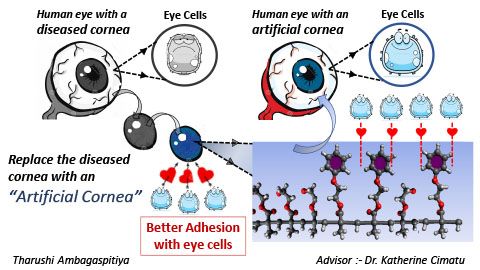By Kate Nichols
NQPI Editorial Intern
Nanoscale and Quantum Phenomena Institute 2020 Spring Newsletter
Physical Chemist and NQPI member Dr. Katherine Cimatu and her group focus on investigating the surface and interfacial properties of soft polymers. Polymers are substances made up of a chain of repeated monomers. Creating a multifunctional polymeric material involves combining the unique physicochemical and mechanical properties of individual polymers. Her group fabricated a copolymer and prepared polymer thin films to study their morphology, adhesion properties, and their chemical make-up at the polymer-air interface. These materials play an essential role in coatings, sensors, and biomaterials.
In their research, the copolymer thin films are made of a hydrogel and another substituted methacrylate-based polymer. A hydrogel is a polymeric material used in contact lenses, wound dressings, hygiene products, diapers, tissue engineering, and even drug delivery. Interestingly, this specific copolymer could be used as a material for artificial corneas in keratoprosthesis—a surgical procedure that replaces a diseased human cornea with an artificial one. This distinct combination of the two polymers improves their adhesion property. Hydrogels can retain and absorb water (suitable for biological surfaces) and the addition of the other polymer helps in attaching the material better to the same surface.

Surface properties of a HEMA and PhEMA copolymer are investigated using AFM and SFG Spectroscopy. This copolymer is an alternative hydrogel material for making artificial human corneas. Illustration: Tharushi Ambagaspitiya
“I think what we are doing is important because the modifications we introduce and characterizations we perform help us learn about the structure-property relationships of relevant materials allowing us to design new materials with improved surface and interfacial properties,” says Cimatu.
Cimatu and her group are interested in looking at testing the biocompatibility of these modified copolymers, which will be useful for developing polymeric materials not just for artificial corneas, but also for contact lenses and bio-adhesive tapes.




















Comments